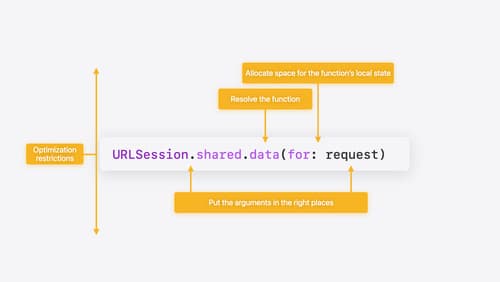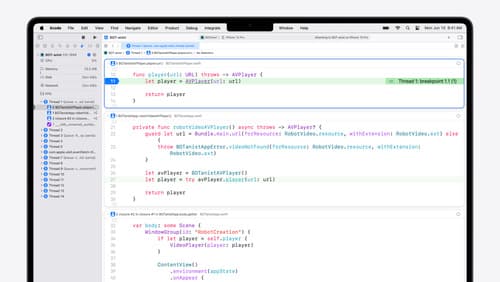how to improve uitableview performance
Asked on 2024-08-01
1 search
To improve the performance of UITableView, you can consider several strategies and techniques discussed in various WWDC sessions:
-
Optimize Memory Management:
- Whole Module Optimization: Ensure whole module optimization is enabled to reduce overhead by allowing more inlining. This can help improve the performance of your code by optimizing how functions are called and executed (Analyze heap memory).
- Reduce Retain and Release Overhead: Avoid circumventing ARC (Automatic Reference Counting) and instead, use techniques like marking methods as
@objcdirect to allow inlining of Objective-C method calls, which helps reduce retain and release traffic (Analyze heap memory).
-
Concurrency Management:
- Adopt Swift Concurrency: By adopting Swift concurrency, you can manage background operations more efficiently, reducing the load on the main thread and improving the responsiveness of your
UITableView(Migrate your app to Swift 6).
- Adopt Swift Concurrency: By adopting Swift concurrency, you can manage background operations more efficiently, reducing the load on the main thread and improving the responsiveness of your
-
Profiling and Debugging:
- Use Instruments and Flame Graphs: Utilize Instruments' new flame graph feature to get a high-level overview of your code's execution and identify performance bottlenecks. This can help you spot issues like loading assets serially on the main thread and move such operations to the background (What’s new in Xcode 16).
- Thread Performance Checker: Use the thread performance checker in Xcode to identify and fix issues related to loading data on the main thread, which can significantly impact the performance of your
UITableView(What’s new in Xcode 16).
-
Efficient Data Handling:
- Optimize Data Queries: If your
UITableViewrelies on data queries, consider using SwiftData's indexing capabilities to make queries faster and more efficient. This can help in reducing the time it takes to sort and filter data for display in your table view (What’s new in SwiftData).
- Optimize Data Queries: If your
By implementing these strategies, you can significantly improve the performance of your UITableView, making your app more responsive and efficient.

Explore Swift performance
Discover how Swift balances abstraction and performance. Learn what elements of performance to consider and how the Swift optimizer affects them. Explore the different features of Swift and how they’re implemented to further understand the tradeoffs available that can impact performance.

What’s new in Xcode 16
Discover the latest productivity and performance improvements in Xcode 16. Learn about enhancements to code completion, diagnostics, and Xcode Previews. Find out more about updates in builds and explore improvements in debugging and Instruments.

What’s new in SwiftData
SwiftData makes it easy to add persistence to your app with its expressive, declarative API. Learn about refinements to SwiftData, including compound uniqueness constraints, faster queries with #Index, queries in Xcode previews, and rich predicate expressions. Join us to explore how you can use all of these features to express richer models and improve performance in your app. To discover how to build a custom data store or use the history API in SwiftData, watch “Create a custom data store with SwiftData” and “Track model changes with SwiftData history”.
